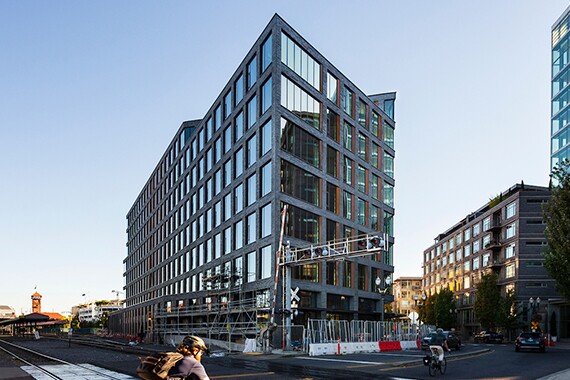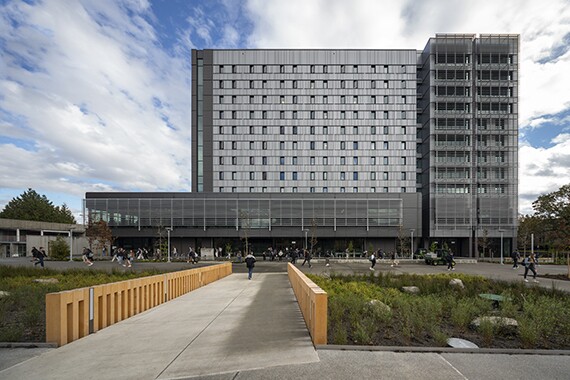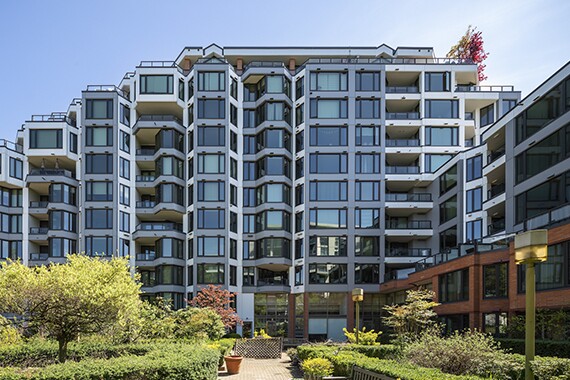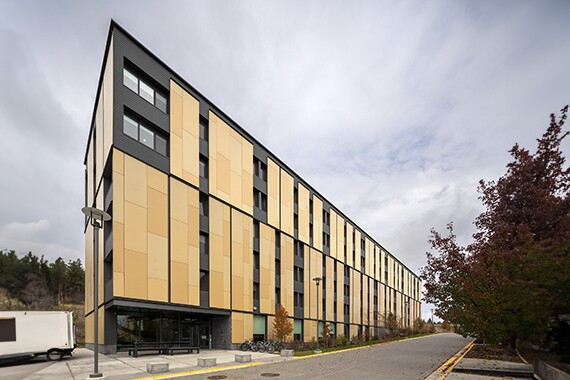
Webinars
WEBINARS
Beyond the Frame: How High-Performance Fenestration Expands Design Possibility
LEARNING CREDIT - 1hr (AIA, AIBC, ASTTBC, BC Housing, OAA, BOABC)
As energy codes and performance standards across North America become more rigorous—such as the BC Energy Step Code, Energize Denver, and the Massachusetts Stretch Code—architects, engineers, and envelope consultants face increasing pressure to deliver efficient buildings without sacrificing aesthetics or affordability.
This session explores how adopting a whole-building design mindset, with a focus on high-performance fenestration, can unlock new flexibility for project teams. Rather than viewing windows and doors as constraints, high-performance fenestration can be leveraged as design enablers that contribute to thermal efficiency, visual appeal, and user comfort—while also supporting cost-effective compliance with evolving energy mandates.
Through case studies and comparative analysis, attendees will learn how fenestration decisions influence overall envelope strategy, and how integrating these components early in design offers greater control over architectural expression, interior quality, and project budgets.
AIA Provider Number: 40107438 | AIA Course Number - CW-ED-26 | 1LU/HSW
NOTE: AIA & AIBC credits are reported automatically by Cascadia. All other learning credits can be self-reported to the respective governing bodies.
Thurs, Dec 11 @ 9am PST (12pm EST)
Previous Session -
Download Presentation (PDF) - Beyond the Frame: How High-Performance Fenestration Expands Design Possibility
Tackling Window Pain: Understanding the benefits of high-performance fenestration
LEARNING CREDIT - 1hr (AIA, AIBC, ASTTBC, BC Housing, OAA, BOABC)
As jurisdictions across North America introduce more stringent building energy performance standards (BEPS)—such as the BC Step Code and Seattle 2018 update—developers, architects, and contractors are left wondering the best way to meet the new benchmarks while controlling costs. This balance can seem daunting, especially when it comes to incorporating manufactured components, such as windows. Fortunately, a general understanding of the impacts of high-performance fenestration can help keep a project on track.
This presentation delves into modern high-performance fenestration products, providing a high-level overview of what makes a product ‘high-performance’, benefits of high-performance fenestration in the world of emerging BEPS, plus real-world project examples.
Through a review of window materials and configurations, this presentation outlines the impacts of fenestration on a building envelope’s overall performance, as well as opportunities to cost-optimize high-performance fenestration.
AIA Provider Number: 40107438 | AIA Course Number - CW-ED-21 | 1LU/HSW
NOTE: AIA & AIBC credits are reported automatically by Cascadia. All other learning credits can be self-reported to the respective governing bodies.
Previous Session -
Download Presentation (PDF) - Tackling Window Pain: Understanding the benefits of high-performance fenestration
Window of Opportunity: Leveraging Passive House Windows in Commercial & Residential Buildings
LEARNING CREDIT - 1hr (AIA, AIBC, ASTTBC, BC Housing, OAA, BOABC)
As the demand for enhanced building energy performance continues to rise across North America, the Passive House standard is gaining significant traction. For those new to this rigorous standard, it can appear complex—especially when it comes to integrating manufactured components like windows. However, understanding window configuration and calculations for Passive House projects doesn’t have to be intimidating.
This session delves into the Passive House approach to windows, offering a concise overview of the building science principles behind the standard, the metrics used to measure its performance, and its practical validation in real-world applications. Additionally, it highlights the advantages Passive House windows provide to building occupants.
By examining various window materials and configurations, this presentation showcases pathways to achieving the Passive House standard and identifies strategies to optimize costs while maintaining high-performance fenestration.
AIA Provider Number: 40107438 | AIA Course Number - CW-ED-24 | 1LU/HSW
NOTE: AIA & AIBC credits are reported automatically by Cascadia. All other learning credits can be self-reported to the respective governing bodies.
Wed, Dec 10 @ 9am PST (12pm EST)
Previous Session -
Download Presentation (PDF) - Window of Opportunity: Leveraging Passive House Windows in Commercial & Residential Buildings
From Restoration to Innovation: Leveraging Rehabilitation ‘Lessons Learned’ to Drive Adoption of High-Performance Building Envelope Products
LEARNING CREDIT - 1hr (AIA, AIBC, ASTTBC, BC Housing, OAA, BOABC)
Building envelope rehabilitation projects offer valuable insights into the real-world performance of building designs and products over time and highlight key opportunities to increase the overall performance of buildings in the future—both rehabs and new construction.
The presentation highlights four key lessons learned from various building envelope rehabilitation projects. Through reviewing project case studies, trends emerge surrounding common envelope failures, opportunities to shift buildings towards net zero, the importance of lifecycle cost analysis, and leveraging environmental impact data when selecting construction materials.
AIA Provider Number: 40107438 | AIA Course Number - CW-ED-22 | 1LU/HSW
NOTE: AIA & AIBC credits are reported automatically by Cascadia. All other learning credits can be self-reported to the respective governing bodies.
Previous Session -
Download Presentation (PDF) - From Restoration to Innovation
Closing the Gap: Leveraging Cladding Attachments to Deliver High-Performance Exterior Wall Assemblies
LEARNING CREDIT - 1hr (AIA, AIBC, ASTTBC, BC Housing, OAA, BOABC)
Jurisdictions across North American continue to transition beyond ASHRAE standards for exterior wall assemblies, instead adopting a more comprehensive building energy performance standard (BEPS) approach to envelope design.
This shift brings advantages like increased design flexibility and reduced operating costs, but it also calls for a rethinking of how these wall assemblies are constructed. Instead of relying on traditional line-by-line methods, the performance of individual components must be considered along side their overall impact on the entire high-performance exterior walls assembly.
This webinar will explore the role of thermal bridging in meeting new BEPS, as well as ASHRAE standards. It will cover common insulation methods—including interior, split, and exterior applications—and present strategies to minimize thermal bridging through different cladding attachments. The session will conclude with real-world case studies that highlight the importance of an integrated approach to component performance in achieving optimal results.
AIA Provider Number: 40107438 | AIA Course Number - CC-ED-21 | 1LU/HSW
NOTE: AIA & AIBC credits are reported automatically by Cascadia. All other learning credits can be self-reported to the respective governing bodies.
Previous Session -
Download Presentation (PDF) - Closing the Gap: Leveraging cladding attachments to deliver high-performance exterior wall assemblies
Mind the Gap: Better exterior wall performance through cladding attachments
LEARNING CREDIT - 1hr (AIA, AIBC, ASTTBC, BC Housing, OAA, BOABC)
Many North American jurisdictions are moving beyond ASHRAE performance requirements for exterior wall assemblies, shifting instead to a holistic, building energy performance standard (BEPS) approach. While this evolution offers benefits—such as design flexibility and lower operating costs—it also requires a new approach to building those assemblies.
A line-item-by-line-item approach no longer yields the best results. Instead, component performance needs to be viewed across multiple facets to build high-performance exterior wall assemblies. This presentation discusses the impacts of thermal bridging on compliance with emerging building energy performance standards (BEPS), as well as ASHRAE.
Reviewing common insulation solutions—including interior, split and exterior insulation methods—the session delves into strategies for limiting thermal bridging through various cladding attachments. Finally, a review of real-world case studies helps demonstrate the interconnectivity of component when achieving high-performance.
AIA Provider Number: 40107438 | AIA Course Number - CW-ED-17 | 1LU/HSW
NOTE: AIA & AIBC credits are reported automatically by Cascadia. All other learning credits can be self-reported to the respective governing bodies.
Previous Session -
Download Presentation (PDF) - Mind the Gap: Better exterior wall performance through cladding attachments
Wildfire Resistance: Window Strategies for Wildland-Urban Interface (WUI) Design
LEARNING CREDIT – 1hr (AIA, AIBC, BC Housing)
As wildfires increase in frequency and intensity across North America, architects, engineers, and builders face growing responsibility to design buildings that can better withstand these extreme events—especially in Wildland-Urban Interface (WUI) zones.
Windows are among the most vulnerable points in the building envelope during a wildfire. Yet with thoughtful design and product selection, they can become a crucial line of defense. This session provides a focused exploration of strategies to enhance window wildfire resistance in fire-prone environments. Attendees will be introduced to key performance considerations for window assemblies, covering fire exposure mechanisms, material behavior, and construction details that affect survival in WUI conditions.
Through case studies, test data, and performance comparisons, attendees will gain practical insight into current wildfire-resistance guidance in both the U.S. and Canada, including California’s State Fire Marshal (SFM) Standard Test Method 12-7A-2 and FireSmart Canada recommendations. The session also provides an overview of material selection, construction detailing, and system integration strategies that can reduce ignition risk and improve building survivability in fire-prone regions.
AIA Provider Number: 40107438 | AIA Course Number - CW-ED-27 | 1LU/HSW
NOTE: AIA & AIBC credits are reported automatically by Cascadia. All other learning credits can be self-reported to the respective governing bodies.
Previous Session -
Combustible Windows & Façade Components in Non-Combustible Construction – Testing, Research, and Expanding Methods
LEARNING CREDIT - 1 hr (AIA, AIBC, ASTTBC, BC Housing, OAA, BOABC)
We desperately need better energy efficiency from building enclosures, from both windows and insulated wall assemblies. Today, the best products and components to enable this are generally made from low conductivity materials. Most of these materials also happen to be combustible—at least, to some extent.
Even so, combustible components such as cladding supports and window frames can be safely used in non-combustible construction.
AIA Provider Number: 40107438 | AIA Course Number - CW-ED-18 | 1LU/HSW
NOTE: AIA & AIBC credits are reported automatically by Cascadia. All other learning credits can be self-reported to the respective governing bodies.
Previous Session -
Download Presentation (PDF) - Combustible Windows & Façade Components in Non-Combustible Construction – Testing, Research, and Expanding Methods
Cascadia offers private lunch-and-learn presentations for each of our educational webinars, both in-person and virtually. To reserve a spot for your firm, simply click the link below and fill out the form.
Want a different time? Send us an email to schedule a specific time for your session.



